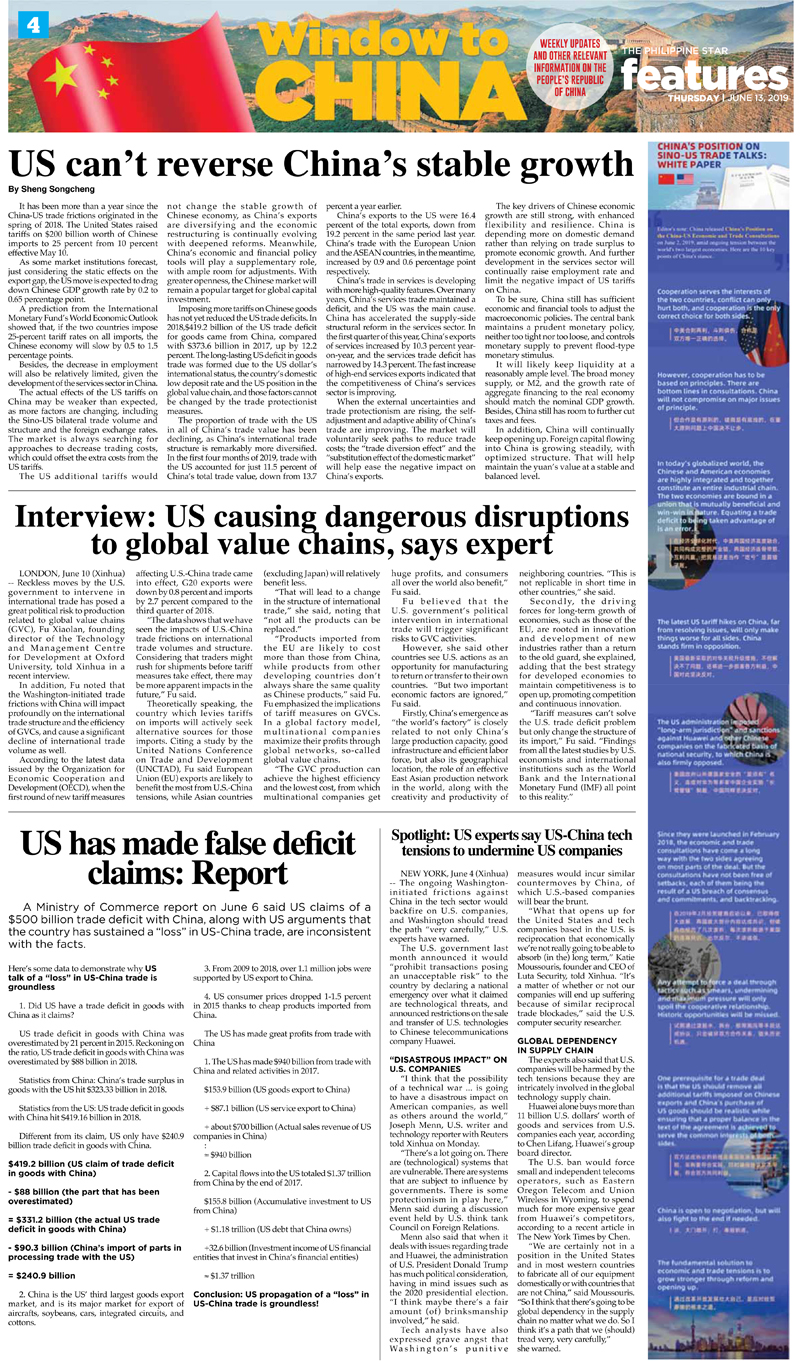US can't reverse China's stable growth
BEIJING — It has been more than a year since the China-US trade frictions originated in the spring of 2018. The United States raised tariffs on $200-billion worth of Chinese imports to 25% from 10% effective May 10.
As some market institutions forecast, just considering the static effects on the export gap, the US move is expected to drag down Chinese GDP growth rate by 0.2 to 0.65 percentage points.
A prediction from the International Monetary Fund’s World Economic Outlook showed that, if the two countries impose 25-percent tariff rates on all imports, the Chinese economy will slow by 0.5 to 1.5 percentage points.
Besides, the decrease in employment will also be relatively limited, given the development of the services sector in China.
The actual effects of the US tariffs on China may be weaker than expected, as more factors are changing, including the Sino-US bilateral trade volume and structure and the foreign exchange rates. The market is always searching for approaches to decrease trading costs, which could offset the extra costs from the US tariffs.
The US additional tariffs would not change the stable growth of the Chinese economy, as China’s exports are diversifying and the economic restructuring is continually evolving with deepened reforms.
Meanwhile, China’s economic and financial policy tools will play a supplementary role, with ample room for adjustments. With greater openness, the Chinese market will remain a popular target for global capital investment.
Imposing more tariffs on Chinese goods has not yet reduced the US trade deficits. In 2018, $419.2 billion of the US trade deficit for goods came from China, compared with $373.6 billion in 2017, up by 12.2 percent.
The long-lasting US deficit in goods trade was formed due to the US dollar’s international status, the country’s domestic low deposit rate and the US position in the global value chain, and those factors cannot be changed by trade protectionist measures.
The proportion of trade with the US in all of China’s trade value has been declining, as China’s international trade structure is remarkably more diversified. In the first four months of 2019, trade with the US accounted for just 11.5% of China’s total trade value, down from 13.7% a year earlier.
China’s exports to the US were 16.4% of the total exports, down from 19.2% in the same period last year. China’s trade with the European Union and the ASEAN countries, in the meantime, increased by 0.9 and 0.6 percentage points, respectively.
China’s trade in services is developing with more high-quality features. Over many years, China’s services trade maintained a deficit, and the US was the main cause. China has accelerated the supply-side structural reform in the services sector.
In the first quarter of this year, China’s exports of services increased by 10.3% year-on-year, and the services trade deficit has narrowed by 14.3%. The fast increase of high-end services exports indicated that the competitiveness of China’s services sector is improving.
When the external uncertainties and trade protectionism are rising, the self-adjustment and adaptive ability of China’s trade are improving. The market will voluntarily seek paths to reduce trade costs; the “trade diversion effect” and the “substitution effect of the domestic market” will help ease the negative impact on China’s exports.
The key drivers of Chinese economic growth are still strong, with enhanced flexibility and resilience. China is depending more on domestic demand rather than relying on trade surplus to promote economic growth.
Further development in the services sector will continually raise the employment rate and limit the negative impact of US tariffs on China.
To be sure, China still has sufficient economic and financial tools to adjust its macroeconomic policies. The central bank maintains a prudent monetary policy—neither too tight nor too loose—and controls monetary supply to prevent flood-type monetary stimulus.
It will likely keep liquidity at a reasonably ample level. The broad money supply, or M2, and the growth rate of aggregate financing to the real economy should match the nominal GDP growth. Besides, China still has room to further cut taxes and fees.
In addition, China will continually keep opening up. Foreign capital flowing into China is growing steadily, with optimized structure. That will help maintain the yuan’s value at a stable and balanced level.

- Latest






























